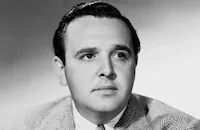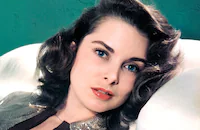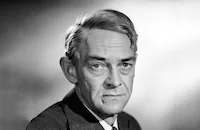Who Was That Lady?

Brief Synopsis
Cast & Crew
George Sidney
Tony Curtis
Dean Martin
Janet Leigh
James Whitmore
John Mcintire
Film Details
Technical Specs

Synopsis
When Ann Wilson catches her husband David, a chemistry professor at Columbia University, kissing one of his shapely students, she storms out of his office, yelling that she wants a divorce and expects David to vacate their apartment by 7 p.m. that night. Soon after, David's good friend, television writer Michael Haney, comes to the chemistry lab, and when David tells Mike about his predicament, Mike is incredulous that Ann would be so upset over something as insignificant as a kiss. As David plies Mike with a high-octane alcoholic brew he has whipped up in the lab, Mike concocts a brilliant excuse that would justify David's indiscretion: David should tell Ann that he is an FBI agent and kissed the student, a foreign agent, in the line of duty. To convince Ann, Mike tricks Schultz, the prop man at the television studio, into fabricating an FBI identification card for David and supplying him with a gun. He also tattoos dots on David's foot, which he later tells Ann are identifying marks of an FBI agent. That night, when Ann comes home to pack her suitcase to go to Reno for a divorce, Mike and David roll out their FBI story. Ann refuses to believe them until David produces his identification card and gun, and thrilled by the idea of being married to a daring secret agent, eagerly forgives him. The next day, Schultz, who has become suspicious because the identification card was not used for Mike's show, goes to the FBI office to report that Mike requested a fake FBI card. Assigned to investigate the matter, agent Harry Powell goes to the Wilsons' apartment, where he is greeted by Ann, who announces that her husband is an agent, too. Powell begins to understand David's motivation when Ann breathlessly reports that her husband was forced to "kiss a girl in the line of duty." Because Ann reminds him of his daughter, Powell recommends to his superior, Bob Doyle, that David only be admonished for his impersonation rather than face criminal charges. That night, as David comes home bearing gifts for Ann, Mike rings the doorbell and announces that he and David have been assigned to go to Lee Wong's restaurant in Times Square to meet two foreign agents. After pulling David out the door, Mike chortles that the two agents are "sensational dames." In his haste, David has left his gun behind, and as Ann races out to give it to David, she is met by Powell, who has come to have a talk with David about impersonating an agent. Gushing that her husband is on assignment, Ann drags Powell to the restaurant, where Mike and David are drinking with the buxom Coogle sisters, Gloria and Florence. Ann beams with approval as she watches Mike and David down drinks with the Coogles, proudly observing that David is getting them drunk to "loosen their tongues." Mike tells the sisters, who are promoting their song and dance routine, that David is vice president of CBS Television and "might be interested in using them." When the girls excuse themselves to go to the ladies' room, Ann insists on letting her husband know that his colleague Powell is there, and sneaks under David's table to inform him that an FBI agent is watching them. Ann then follows the girls to the ladies' room, entering just as they end a phone call with their agent, who has told them that David is a phony. When the sisters conspire to "get rid of David," Ann is certain that her husband's life is in danger. Trying to avoid Powell, David and Mike run out of the restaurant, and Ann, brandishing David's gun, runs after them. As Powell and Mike try to wrestle the gun from Ann, the weapon fires, drawing the attention of a passing CBS news truck and several reporters. When questioned by the CBS reporter, Ann exclaims that her husband is an FBI agent. The story of the FBI agent firing a gun in Times Square is broadcast nationwide, and as Bob tries to explain the situation to his superiors, Parker, a CIA agent who believes that David is a real FBI agent, comes to berate Bob for withholding information from the CIA. Parker explains that the CIA has been wiretapping Belka, a Soviet agent, and has intercepted a call in which Belka mentions two women in a restaurant. Meanwhile, a man claiming to represent FBI public relations phones the Wilsons to request a photo session with them and Mike at the Empire State Building that afternoon. Certain that he and Mike are going to be arrested, David is about to confess all to Ann when Mike arrives, escorted by an FBI agent, to take David to headquarters. On the way there, Mike and David calculate that they will be spending the next 180 years in prison and blame each other for their dilemma. As Bob questions Mike and David at the FBI office, Parker arrives with the news that they have intercepted another call from Belka in which he is posing as an FBI public relations man. When David mentions that he was just contacted by someone from FBI public relations, they realize that Belka is trying to set them up. Hoping to trap the spy, Bob insists that they keep their date with him that afternoon. As FBI agents surveil the building, Belka appears and Ann, still thinking that he is an FBI PR man, ecstatically follows him into the elevator with Mike and David. Inside are two burly men, and after the doors close and the elevator starts moving, Belka pulls out a gun and stops the elevator between floors. After knocking out Mike and David and drugging Ann, one of the men, Orenov, injects David with truth serum to make him reveal the names of the scientists who are working on a secret government project. Orenov mistakes David's ignorance for disciplined resolve in the face of the enemy, and as the real FBI agents struggle to free the elevator, Belka sends the car to the lower basement of the building. Convinced that David's strength of character will never allow him to divulge state secrets, the spies flee. When Ann revives, David, still under the influence of the truth serum, confesses everything, sending Ann running out of the basement in a fury. Still groggy from the drug, David surveys his surroundings and concludes that the spies have imprisoned them aboard a submarine. After David convinces Mike that it is their patriotic duty to sink the sub, they open the steam valves, singing "America, the Beautiful" while bravely awaiting their demise. As the water floods out, the building's utilities break down, and Powell and the others hurry to the basement to discover what is wrong. Finding David and Mike knee-deep in water, Powell informs them that the spies have been apprehended and that Ann knows everything. As Powell coaxes the downhearted David into extolling Ann's virtues, Ann, who has been standing at the door, listens. When David sees her reflection in the water, he turns around and they kiss. Mike, David and Ann then run out into the street and jump into a cab as a cloud of smoke pours from the top of the Empire State Building.

Director

George Sidney
Cast

Tony Curtis

Dean Martin

Janet Leigh

James Whitmore

John Mcintire

Barbara Nichols

Larry Keating
Larry Storch

Simon Oakland

Joi Lansing
Barbara Hines
Marion Javits
Michael Lane
Kam Tong
William Newell
Mark Allen
Snub Pollard
Jim Shen
Emil Sitka

Peter Thompson
Ron Hayes
John Ward
Bill Boyett

Jack Benny
Art Gilmore
Larry Blake

Wally Brown
Frank Scannell
Alan Carney
Nadine Ducas
Larri Thomas
Donna Lynne
Frank Butler
Crew
Katharine Lee Bates
Sammy Cahn
James M. Crowe
James Flaster
Larry Germain
Edward Haworth
Helen Hunt
Norman Krasna
Norman Krasna
Ben Lane
Viola Lawrence
Jean Louis
Shelley Manne
Red Mitchell
André Previn
Charles J. Rice
David Silver
Harry Stradling
James Van Heusen
Samuel Augustus Ward

Videos
Movie Clip



Film Details
Technical Specs

Articles
Who Was That Lady?
The zany plot, based on the Norman Krasna play Who Was That Lady I Saw You With?, begins when Curtis, an Assistant Professor of Chemistry at Columbia University, is caught by his wife (Janet Leigh) kissing one of his sexy female students. In a desperate bid to keep his marriage together, Curtis employs the help of his TV writer friend (Dean Martin) to concoct an excuse to explain his illicit behavior to his jealous wife. The elaborate ruse they come up with has Curtis working secretly with the F.B.I. Before they know it, Curtis and Martin are in over their heads and find themselves mixed up with some real life Russian spies that leads to some outrageously fun complications.
According to Janet Leigh, she, Curtis and Martin had the time of their lives making Who Was That Lady?. "This was a romp from start to finish; I hope the audience had as much fun as we did," she says in her 1984 autobiography There Really Was a Hollywood. "We really rolled with this one. The personal familiarity of the three of us allowed absolute freedom, and the interplay was wild and woolly and inventive." There was an atmosphere of playfulness on the set that lent itself to practical jokes, attempts to make each other laugh in the middle of takes, and escalating water fights. "...it started innocently and quietly," Leigh explains about the water fights in her book. "A paper cup here, a flick there. It grew to water guns, first casually, then ambush. We would wait on top of our dressing rooms for one unsuspecting victim to return from lunch or the restroom and attacked from above with one or two weapons." The good times on the set helped mask the otherwise troubled marriage between Janet Leigh and Tony Curtis. Who Was That Lady? was the fifth and final film the pair made together before their divorce in 1962.
Who Was That Lady? did respectable business at the box office, and both audiences and critics responded positively to the clever comedy. Variety called it "an often hilarious romp made somewhat sedate only in a compromise between farce and romantic comedy... Curtis and Martin work nicely together, and much of the film depends upon their teamwork. James Whitmore, not ordinarily thought of as a comedian, gets the film's biggest single laughs, mostly on reaction shots of no lines, just looks." The New York Times said, "...the real fun is watching the two bland schemers (Curtis and Martin) as they whip up their fantastic yarn about the husband's sideline 'career,' with some wry throwbacks to their past prowlings. Mr. Martin, especially, is fine, as a highly seasoned bachelor and a glib concocter of video shows."
Who Was That Lady? also features a spirited jazz score by André Previn; Dean Martin sings the title song written by Sammy Cahn.
Producer: Norman Krasna
Director: George Sidney
Screenplay: Norman Krasna (play "Who Was That Lady I Saw You With?")
Cinematography: Harry Stradling, Sr.
Art Direction: Ted Haworth
Music: André Previn
Film Editing: Viola Lawrence
Cast: Tony Curtis (David Wilson), Dean Martin (Michael Haney), Janet Leigh (Ann Wilson), James Whitmore (Harry Powell), John McIntire (Bob Doyle), Barbara Nichols (Gloria Coogle), Larry Keating (Parker), Larry Storch (Orenov), Simon Oakland (Belka).
BW-113m.
by Andrea Passafiume

Who Was That Lady?
Quotes
Trivia
Notes
Onscreen credits read "you are hearing the voice of Dean Martin singing his latest Capitol Recording "Who Was That Lady?" as the opening credits role. According to a July 1958 Los Angeles Examiner news item, Bob Hope and Bing Crosby were interested in starring in the film version of Norman Krasna's play. A March 1959 Los Angeles Examiner news item noted that Debbie Reynolds was to co-star in the film. André Previn was borrowed from M-G-M to score the picture. At the time of the film's release, Tony Curtis and Janet Leigh were married. Who Was That Lady was the fifth and last time that they starred together before their divorce in 1962.
Comedians Alan Carney and Wally Brown had not acted together since the 1946 RKO film Vacation in Reno. Marion Javitz, who played "Miss Mellish," was the wife of then New York senator Jacob Javits. Although production notes in the film's production file at the AMPAS Library stated that Who Was That Lady was to be the motion picture acting debut of Barbara Binyon, the daughter of writer-director Claude Binyon, her appearance in the film has not been confirmed. Although the Filmfacts review lists Harry Jackson as playing the role of "Joe Bendix," both the CBCS and Variety review credit Mark Allen in the part. Who Was That Lady? marked the only joint production between Ansark (which was owned by Krasna) and George Sidney.
A January 1967 ^DV article noted that writer Valentine Davies sued Krasna on the grounds that Krasna's play was based on a story entitled "Love Must Go On," which Davies had submitted to Krasna. After Davies' death on July 23, 1961, his widow continued with the suit, and after a December 1963 court ruling determined that no agreement about the rights to the story existed between Davies and Krasna, the Davies estate appealed the ruling. In November 1966, after having the case for more than two-and-a-half years, the District Court of Appeals ruled that a producer becomes "a party in confidence" to a literary property, as only by discussing it can the writer make his pitch. Under this ruling, a breach of the trust between the producer and writer is grounds for recovery of damages. The amount of damages awarded to the Davies estate is unknown.

Miscellaneous Notes
Released in United States Winter February 1960
Released in United States Winter February 1960













